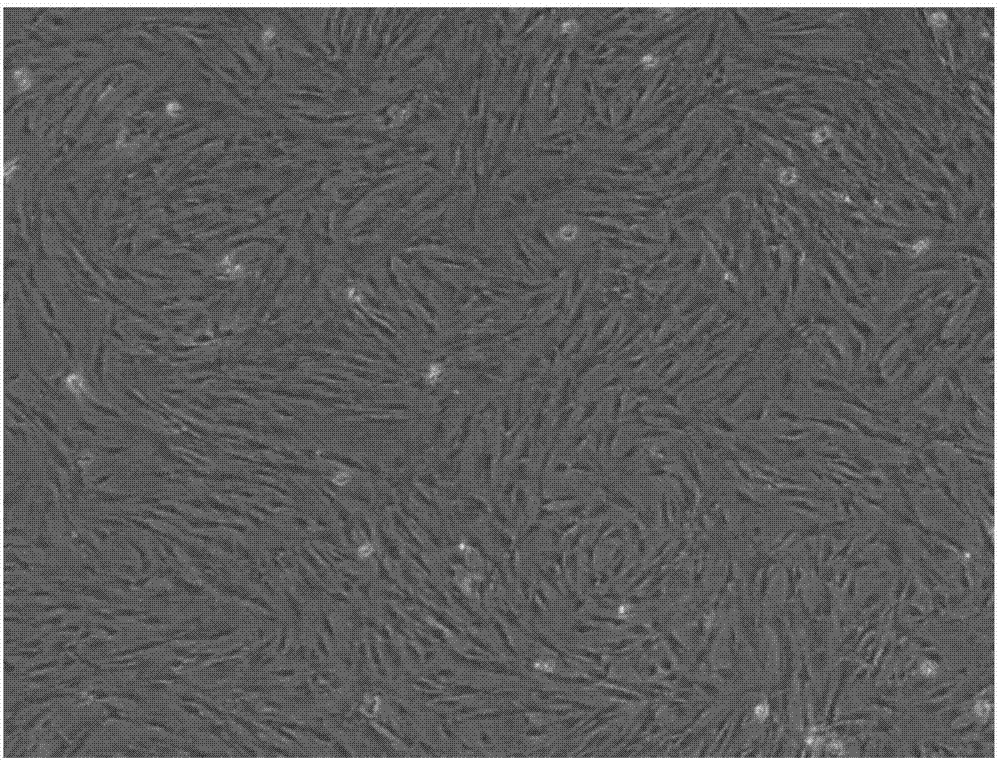Preparation method and application of exosome derived from human olfactory mucosa mesenchymal stem cells
A technology of stem cells and exosomes, applied in the field of stem cells, can solve the problems such as the inability to obtain the amount of exosomes, the poor stability of the separation effect of exosomes, and the damage of vesicles.
- Summary
- Abstract
- Description
- Claims
- Application Information
AI Technical Summary
Problems solved by technology
Method used
Image
Examples
preparation example Construction
[0034] The present invention provides a method for preparing exosomes derived from human olfactory mucosa mesenchymal stem cells, comprising the following steps: 1) when the fusion rate of P4 and / or P5 generation olfactory mucosa mesenchymal stem cells is 85-90% , to obtain a cell culture; 2) performing a first centrifugation on the cell culture obtained in the step 1) to obtain a first supernatant and a first precipitate, and the speed of the first centrifugation is 200 to 400 rpm; 3 ) performing a second centrifugation on the first supernatant obtained in step 2) to obtain a second supernatant and a second precipitate, the speed of the second centrifugation is 2,000-3,000 rpm; 4) the The second supernatant obtained in step 3) is subjected to a third centrifugation to obtain a third supernatant and a third precipitate, and the gravitational acceleration of the third centrifugation is 9,000-11,000 g; 5) the step 4) The obtained third supernatant was filtered to remove large ve...
Embodiment 1
[0074] Culture and identification of olfactory mucosal mesenchymal stem cells
[0075] Primary culture of olfactory mucosal mesenchymal stem cells: Obtain 1 piece of olfactory mucosal tissue (size 2×3mm), wash it repeatedly with 1% penicillin 3 times under sterile conditions to remove residual blood; Cut it to about 1mm in length 3 The tissue pieces were placed in a 15ml centrifuge tube, mixed with 2ml of complete medium and shaken, evenly planted in a cell culture dish, and placed at 37°C, 5% CO 2 Cultivate in the incubator; On the 7th day of cultivation, the cells climbed out, and observed spindle-shaped or polygonal cells attached to the wall under the microscope (results in figure 1 ), after which the complete medium was replaced every 3 days; on the 15th day of culture, the cells were about 85% confluent and could be passaged.
[0076] Subculture of olfactory mucosal mesenchymal stem cells: Take subcultured P0 cells, discard the original culture medium in the dish, add ...
Embodiment 2
[0079] Obtaining and identification of exosomes from olfactory mucosal mesenchymal stem cells:
[0080] Obtaining exosomes:
[0081] Collect 100 ml of the cell culture supernatant obtained in Example 1, and perform preliminary centrifugation (divided into 3 times) at 4°C to remove impurities. The first time: the centrifugation speed is 300 rpm, and the time is 5 min; the second time: the centrifugation speed is 2,500 rpm, the time is 30min; the third time: the centrifugation temperature is 4°C, the centrifugal gravity acceleration is 10,000g, and the time is 60min; the supernatant after centrifugation is collected and filtered through a 0.22μm filter membrane; then the collected filtrate is added in a volume ratio of 1:1 20% polyethylene glycol solution with a number average molecular weight of 6000, mix well and incubate for 8 hours, centrifuge at 4°C, gravity plus centrifuge speed 100,000g for 60min, resuspend the obtained precipitate with normal saline, mix well Centrifuge...
PUM
| Property | Measurement | Unit |
|---|---|---|
| pore size | aaaaa | aaaaa |
Abstract
Description
Claims
Application Information
 Login to View More
Login to View More - R&D
- Intellectual Property
- Life Sciences
- Materials
- Tech Scout
- Unparalleled Data Quality
- Higher Quality Content
- 60% Fewer Hallucinations
Browse by: Latest US Patents, China's latest patents, Technical Efficacy Thesaurus, Application Domain, Technology Topic, Popular Technical Reports.
© 2025 PatSnap. All rights reserved.Legal|Privacy policy|Modern Slavery Act Transparency Statement|Sitemap|About US| Contact US: help@patsnap.com



